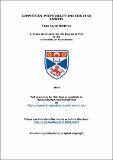Files in this item
Competition, profitability and risk in US banking
Item metadata
| dc.contributor.advisor | Wilson, John O. S. | |
| dc.contributor.advisor | Chronopoulos, Dimitris | |
| dc.contributor.author | McMillan, Fiona Jayne | |
| dc.coverage.spatial | 276 | en_US |
| dc.date.accessioned | 2015-04-30T14:54:47Z | |
| dc.date.available | 2015-04-30T14:54:47Z | |
| dc.date.issued | 2014-11 | |
| dc.identifier.uri | https://hdl.handle.net/10023/6609 | |
| dc.description.abstract | This thesis is concerned with the relationships between profit, profit persistence, risk and competition within the US commercial bank sector. In particular, the thesis asks three questions: how profit and profit persistence are affected by changes in regulation designed to enhance competition; how profit persistence varies over time according to changes in market and economic conditions; how different aspects of banks’ risk is affected by competition and market structure. Understanding the nature of these relationships is important given the prominent role banks play in the allocation of resources, the provision of capital to the economy and the stability of the financial system. Moreover, these roles in turn, have an effect on bank performance and wider economic growth and stability. Such issues have especially come to prominence following the financial crisis and thus there is a need for empirical evidence on which to base policy. To examine these relationships the thesis implements panel estimation techniques and obtains data on all commercial banks, primarily over the period 1984-2009, thus including births and deaths. The key findings show, first, that profit persistence is relatively low compared to previous US banking studies and compared to manufacturing firms. Moreover, persistence varies with regulatory changes, although not always in the expected direction, notably the increase in persistence following the 1999 Gramm-Leach-Bliley Act. Second, additional time-variation in persistence is linked to bank specific, market structure and economic factors. Notably, persistence varies with bank size and market share, market concentration and output growth, but the precise nature of these relationships varies across the sample and by bank size. Third, that there is a difference in the nature of the relationship between competition and loan risk on the one hand and competition and total risk and leverage on the other. We also find that the relationship between risk and market structure varies according to bank size and that the economic cycle influences banks’ risk. The implications and contribution of this thesis lie in establishing empirical evidence for understanding the nature of the relationships between competition, profits and risk. This is particularly prescient given the move towards new regulation following the financial crisis. Key results here show that no simple relationship exists between bank size or market concentration and competition and risk, therefore policy should account for such differences, whether according to bank size or type of risk. | en_US |
| dc.language.iso | en | en_US |
| dc.publisher | University of St Andrews | |
| dc.subject.lcc | HG2491.M6 | |
| dc.subject.lcsh | Competition--United States | en_US |
| dc.subject.lcsh | Bank profits--United States | en_US |
| dc.subject.lcsh | Financial risk--United States | en_US |
| dc.subject.lcsh | Banks and banking--United States | en_US |
| dc.title | Competition, profitability and risk in US banking | en_US |
| dc.type | Thesis | en_US |
| dc.type.qualificationlevel | Doctoral | en_US |
| dc.type.qualificationname | PhD Doctor of Philosophy | en_US |
| dc.publisher.institution | The University of St Andrews | en_US |
This item appears in the following Collection(s)
Items in the St Andrews Research Repository are protected by copyright, with all rights reserved, unless otherwise indicated.

